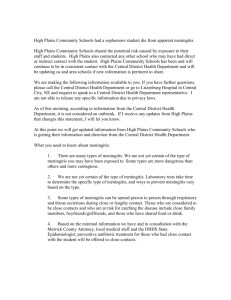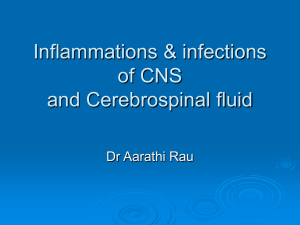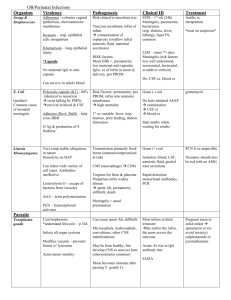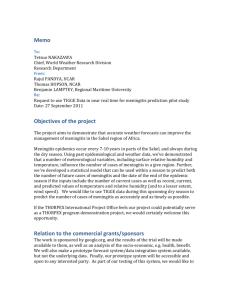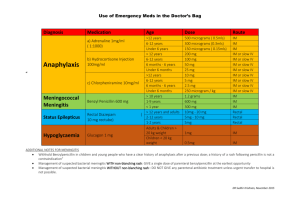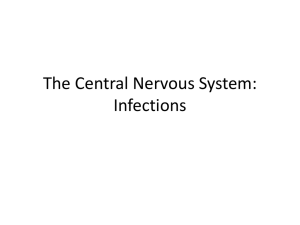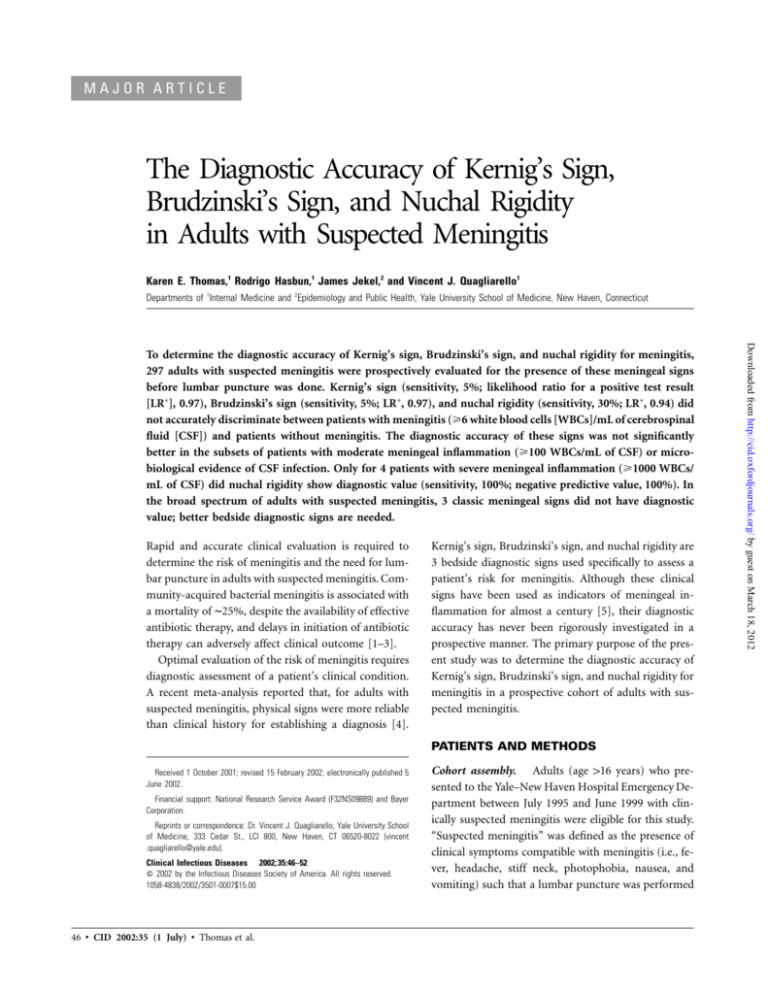
MAJOR ARTICLE
The Diagnostic Accuracy of Kernig’s Sign,
Brudzinski’s Sign, and Nuchal Rigidity
in Adults with Suspected Meningitis
Karen E. Thomas,1 Rodrigo Hasbun,1 James Jekel,2 and Vincent J. Quagliarello1
Departments of 1Internal Medicine and 2Epidemiology and Public Health, Yale University School of Medicine, New Haven, Connecticut
Rapid and accurate clinical evaluation is required to
determine the risk of meningitis and the need for lumbar puncture in adults with suspected meningitis. Community-acquired bacterial meningitis is associated with
a mortality of ∼25%, despite the availability of effective
antibiotic therapy, and delays in initiation of antibiotic
therapy can adversely affect clinical outcome [1–3].
Optimal evaluation of the risk of meningitis requires
diagnostic assessment of a patient’s clinical condition.
A recent meta-analysis reported that, for adults with
suspected meningitis, physical signs were more reliable
than clinical history for establishing a diagnosis [4].
Kernig’s sign, Brudzinski’s sign, and nuchal rigidity are
3 bedside diagnostic signs used specifically to assess a
patient’s risk for meningitis. Although these clinical
signs have been used as indicators of meningeal inflammation for almost a century [5], their diagnostic
accuracy has never been rigorously investigated in a
prospective manner. The primary purpose of the present study was to determine the diagnostic accuracy of
Kernig’s sign, Brudzinski’s sign, and nuchal rigidity for
meningitis in a prospective cohort of adults with suspected meningitis.
PATIENTS AND METHODS
Received 1 October 2001; revised 15 February 2002; electronically published 5
June 2002.
Financial support: National Research Service Award (F32NS09889) and Bayer
Corporation.
Reprints or correspondence: Dr. Vincent J. Quagliarello, Yale University School
of Medicine, 333 Cedar St., LCI 800, New Haven, CT 06520-8022 (vincent
.quagliarello@yale.edu).
Clinical Infectious Diseases 2002; 35:46–52
2002 by the Infectious Diseases Society of America. All rights reserved.
1058-4838/2002/3501-0007$15.00
46 • CID 2002:35 (1 July) • Thomas et al.
Cohort assembly. Adults (age 116 years) who presented to the Yale–New Haven Hospital Emergency Department between July 1995 and June 1999 with clinically suspected meningitis were eligible for this study.
“Suspected meningitis” was defined as the presence of
clinical symptoms compatible with meningitis (i.e., fever, headache, stiff neck, photophobia, nausea, and
vomiting) such that a lumbar puncture was performed
Downloaded from http://cid.oxfordjournals.org/ by guest on March 18, 2012
To determine the diagnostic accuracy of Kernig’s sign, Brudzinski’s sign, and nuchal rigidity for meningitis,
297 adults with suspected meningitis were prospectively evaluated for the presence of these meningeal signs
before lumbar puncture was done. Kernig’s sign (sensitivity, 5%; likelihood ratio for a positive test result
[LR+], 0.97), Brudzinski’s sign (sensitivity, 5%; LR+, 0.97), and nuchal rigidity (sensitivity, 30%; LR+, 0.94) did
not accurately discriminate between patients with meningitis (⭓6 white blood cells [WBCs]/mL of cerebrospinal
fluid [CSF]) and patients without meningitis. The diagnostic accuracy of these signs was not significantly
better in the subsets of patients with moderate meningeal inflammation (⭓100 WBCs/mL of CSF) or microbiological evidence of CSF infection. Only for 4 patients with severe meningeal inflammation (⭓1000 WBCs/
mL of CSF) did nuchal rigidity show diagnostic value (sensitivity, 100%; negative predictive value, 100%). In
the broad spectrum of adults with suspected meningitis, 3 classic meningeal signs did not have diagnostic
value; better bedside diagnostic signs are needed.
RESULTS
Description of cohort. A total of 297 adults with suspected
meningitis underwent lumbar puncture; CSF analysis revealed
that 80 (27%) had objective evidence of meningitis (CSF WBC
count ⭓6 cells/mL). Baseline characteristics and clinical presentation of patients with meningitis were similar to those of
patients without meningitis and are shown in table 1.
Emergency department physicians (28% interns, 55% residents, and 17% attending physicians) gathered the clinical
history and conducted physical examinations of patients before performing a lumbar puncture. The most common presenting symptoms were headache (in 84% of patients), fever
(in 68%), nausea and vomiting (in 58%), photophobia (in
53%), and stiff neck (in 46%). The majority (81%) of patients
presented with ⭓2 of these symptoms. The probability of
meningitis associated with different combinations of clinical
symptoms characteristic of meningitis ranged from 0.42 to
0.57 (table 2).
Laboratory results. CSF analysis revealed evidence of meningitis (⭓6 WBCs/mL of CSF) in 80 patients; 29 of those patients had evidence of moderate meningeal inflammation
(⭓100 WBCs/mL of CSF), and 4 had evidence of severe meningeal inflammation (⭓1000 WBCs/mL of CSF). Eighteen patients had microbiological evidence of CSF infection (positive
results of either a CSF culture or an antigen test); the causative
pathogens identified included Enterovirus (8 patients), Cryptococcus neoformans (6 patients), Neisseria meningitidis (2 patients), varicella-zoster virus (1 patient), and Streptococcus pneumoniae (1 patient). Mean CSF indices for patients with and
patients without meningitis are shown in table 1.
Diagnostic accuracy of Kernig’s and Brudzinski’s signs.
Examination for Kernig’s sign and Brudzinski’s sign was done
before lumbar puncture for 237 and 236 patients, respectively.
Seven patients had Kernig’s sign but did not have Brudzinski’s
sign; 7 patients had Brudzinski’s sign but did not have Kernig’s
sign; and 4 patients had both meningeal signs. Neither sign was
found in the remaining patients.
Of the 66 patients with meningitis (⭓6 WBCs/mL of CSF)
who were examined before lumbar puncture was done, 3 had
Kernig’s sign (sensitivity, 5%); of the 171 patients without meningitis who were examined before lumbar puncture, 163 did
not have Kernig’s sign (specificity, 95%) (table 3). Of the 11
patients who displayed Kernig’s sign, 3 had CSF evidence of
meningitis (positive predictive value, 27%); of the 226 patients
who did not display Kernig’s sign, 163 did not have meningitis
(negative predictive value, 72%). The sensitivity (5%), specificity (95%), positive predictive value (27%), and negative predictive value (72%) for Brudzinski’s sign (table 3) were identical
to those for Kernig’s sign. For both Kernig’s sign and Brudzinski’s sign, the LR⫹ was 0.97, the LR⫺ was 1.0, and LR⫹ :LR⫺
was 0.97.
Diagnostic accuracy of nuchal rigidity. All 297 patients
in the cohort were examined for nuchal rigidity before lumbar
puncture was done. Of the 297 patients, 93 had evidence of
nuchal rigidity on physical examination. Of the 80 patients with
meningitis (⭓6 WBCs/mL of CSF), 24 had nuchal rigidity (sensitivity, 30%); of the 217 patients without meningitis, 148 did
not have nuchal rigidity (specificity, 68%) (table 3). Of the 93
patients with nuchal rigidity, 24 had CSF evidence of meningitis
(positive predictive value, 26%); of the 204 patients without
nuchal rigidity, 148 did not have meningitis (negative predictive
value, 73%). The LR⫹ for nuchal rigidity was 0.94, the LR⫺
Diagnostic Accuracy of Signs of Meningitis • CID 2002:35 (1 July) • 47
Downloaded from http://cid.oxfordjournals.org/ by guest on March 18, 2012
to determine whether CSF inflammation was present. A complete description of this cohort has been published elsewhere,
in a study that investigated the usefulness of performance of
head CT before lumbar puncture [6]. Of 301 patients who were
enrolled, 297 underwent lumbar puncture; the remaining 4
patients were excluded on the basis of head CT results that
showed mass effect. The present study was approved by the
Human Investigation Committee at Yale University School of
Medicine, and all enrolled patients consented to participate.
Data collection. All clinical information, including tests
for Kernig’s sign, Brudzinski’s sign, and nuchal rigidity, was
gathered and recorded by an emergency department physician
or physician-investigator before lumbar puncture was done.
Enrolling physicians were required to record the clinical histories of and physical examination findings for research subjects, but physicians were not given explicit instructions about
examination for meningeal signs. All diagnostic and management decisions were at the physician’s discretion.
Laboratory analysis. Laboratory analysis of all CSF samples included Gram staining and bacterial culture, as well as
determination of WBC count and protein and glucose levels.
Additional CSF analysis (i.e., tests for viral, fungal, or mycobacterial pathogens) were ordered at the discretion of the treating physician. Meningitis was considered to be present if the
CSF WBC count was ⭓6 cells/mL.
Statistical analysis. Bivariate analysis was performed using
the x2 test and the t test. P ⭐ .05 was considered to be statistically significant. Standard definitions of sensitivity, specificity,
positive predictive value, and negative predictive value were
used. The likelihood ratio for a positive test result (LR⫹) was
calculated by dividing the sensitivity by the false-positive error
rate. The likelihood ratio for a negative test result (LR⫺) was
calculated by dividing the false-negative error rate by the specificity. The ratio of LR⫹ to LR⫺ (LR⫹ :LR⫺) was calculated to
represent the overall accuracy of the test. Statistical analysis was
performed by use of SAS software (SAS Institute).
Table 1. Baseline characteristics of and clinical presentation for 297 patients with
suspected meningitis.
Patients without
meningitis
Patients with
a
meningitis
All patients
Age, median years (range)
41 (18–93)
37 (22–92)
40 (18–93)
No. (%) of patients 160 years old
37/217 (17)
9/80 (11)
46/297(15)
Characteristic
At baseline
Sex, n/N (%)
Male
97/217 (45)
37/80 (46)
134/297 (45)
120/217 (55)
43/80 (54)
163/297 (55)
104/217 (48)
51/80 (64)
155/297 (52)
Black
68/217 (31)
21/80 (26)
89/297 (30)
Hispanic
40/217 (18)
7/80 (9)
47/297 (16)
5/217 (2)
1/80 (1)
6/297 (2)
162/217 (75)
63/80 (79)
225/297 (76)
HIV positive
38/217 (18)
12/80 (15)
50/297 (17)
Immunosuppressed
17/217 (8)
5/80 (6)
22/297 (7)
Female
Ethnicity, n/N (%)
White
Other
Immunocompetence, n/N (%)
Immunocompromised
Clinical presentation, n/N (%)
Clinical historyb
c
Headache
168/207 (81)
69/75 (92)
237/282 (84)
Fever
144/216 (67)
55/78 (71)
199/294 (68)
Nausea and vomitingd
113/213 (53)
54/77 (70)
167/290 (58)
Photophobia
105/206 (51)
43/75 (57)
148/281 (53)
Stiff neck
97/217 (45)
38/79 (48)
135/296 (46)
Focal motor deficit
20/210 (10)
5/78 (6)
25/288 (9)
Focal sensory deficit
11/206 (5)
2/76 (3)
13/282 (5)
Seizure
12/214 (6)
7/79 (9)
19/293 (6)
Signs
Temperature 138C
112/217 (52)
34/80 (43)
146/297 (49)
Glasgow Coma Scale score !13
16/217 (7)
8/80 (10)
24/297 (8)
Nuchal rigidity
69/217 (32)
24/80 (30)
93/297 (31)
Kernig’s signe
8/171 (5)
3/66 (5)
11/237 (5)
Brudzinski’s signe
8/170 (5)
3/66 (5)
11/236 (5)
CSF analysis findings
WBC count, mean WBCs/mL (SD)
1 (1)
359 (1543)
97 (813)
f
44 (37)
90 (102)
57 (65)
Glucose level, mean mg/dL (SD)
69 (28)
64 (40)
68 (32)
Protein level, mean mg/dL (SD)
NOTE.
a
b
c
d
e
f
Because of rounding, the sum of percentages may not be 100%.
Defined as ⭓6 WBCs/mL of CSF.
Clinical history data were not available for some patients.
Statistically significant difference between patients with and patients without meningitis; P p .028.
Statistically significant difference between patients with and patients without meningitis; P p .009.
N is the no. of patients examined before lumbar puncture was done.
Statistically significant difference between patients with and patients without meningitis; P p .0002.
was 1.02, and LR⫹ :LR⫺ was 0.92. The combination of meningeal signs (i.e., positive results of examination for Kernig’s sign,
Brudzinski’s sign, or nuchal rigidity) had diagnostic values that
were virtually identical to those of nuchal rigidity alone (sen48 • CID 2002:35 (1 July) • Thomas et al.
sitivity, 30%; specificity, 67%; positive predictive value, 25%;
negative predictive value, 72%; LR⫹, 0.92; LR⫺, 1.04; LR⫹ :LR⫺,
0.88).
Diagnostic accuracy of meningeal signs in patients with
Downloaded from http://cid.oxfordjournals.org/ by guest on March 18, 2012
Unimpaired
Table 2. Probability of meningitis for patients with different combinations of clinical symptoms
characteristic of meningitis.
Symptoms
Pretest odds
a
of meningitis
Likelihood ratio
for a positive
test resultb
Posttest odds
c
of meningitis
Headache and fever
.37
1.14
.42
Headache, nausea, and vomiting
.37
1.32
.49
Headache, fever, nausea, and vomiting
.37
1.50
.56
Headache, fever, nausea, vomiting, and photophobia
.37
1.45
.54
Headache, fever, nausea, vomiting, photophobia,
and stiff neck
.37
1.54
.57
a
Calculated by dividing the no. of patients with meningitis by the no. of patients without meningitis. In this cohort, the
pretest odds of meningitis were .37 (80/217).
b
Calculated by dividing the sensitivity by the false-positive error rate.
c
Calculated by multiplying the pretest odds by the likelihood ratio for a positive test result.
In 1909, Brudzinski reported that, for patients with bacterial
or tuberculous meningitis, Kernig’s sign was 57% sensitive, and
Brudzinski’s nape-of-the-neck sign was 96% sensitive [5]. Since
then, the presence of these clinical signs has been interpreted
as evidence of meningeal inflammation. Despite the absence of
rigorous evaluation of their diagnostic utility for almost 100
years, Kernig’s and Brudzinski’s signs are still widely used to
assess the risk of meningitis.
Current data on the diagnostic accuracy of Kernig’s and
Brudzinski’s signs are limited. One study reported sensitivity
Table 3.
Diagnostic accuracy of Kernig’s sign, Brudzinski’s
sign, and nuchal rigidity for patients with suspected meningitis
who were examined for any of these 3 signs before lumbar puncture was done.
No. of patients
With
meningitisa
Sign
Without
meningitis
All
b
Kernig’s
DISCUSSION
In this prospective study, the 3 classic meningeal signs—
Kernig’s sign, Brudzinski’s sign, and nuchal rigidity—were of
limited clinical diagnostic value for adults with suspected meningitis. None of these meningeal signs were able to accurately
discriminate patients with meningitis (⭓6 WBCs/mL of CSF)
from those without it. Furthermore, no significant correlation
existed between these meningeal signs and moderate meningeal
inflammation (⭓100 WBCs/mL of CSF) or between these meningeal signs and microbiological evidence of CSF infection.
Only for the 4 patients with severe meningeal inflammation
(⭓1000 WBCs/mL of CSF) did nuchal rigidity have 100% sensitivity, 100% negative predictive value, and LR⫹ :LR⫺ that approached infinity.
Present
3
8
11
Absent
63
163
226
Brudzinski’sc
Present
3
8
11
Absent
63
162
225
Nuchal rigidityd
Present
24
69
93
Absent
56
148
204
NOTE. LR⫺, likelihood ratio for a negative test result; LR⫹, likelihood ratio
for a positive test result.
a
Defined as ⭓6 WBCs/mL of CSF.
Sensitivity, 5%; specificity, 95%; positive predictive value, 27%; negative
predictive value, 72%, LR⫹, 0.97; LR⫺, 1.0; ratio of LR⫹ to LR⫺, 0.97.
c
Sensitivity, 5%; specificity, 95%; positive predictive value, 27%; negative
predictive value, 72%; LR⫹, 0.97; LR⫺, 1.0; ratio of LR⫹ to LR⫺, 0.97.
d
Sensitivity, 30%; specificity, 68%; positive predictive value, 26%; negative
predictive value, 73%; LR⫹, 0.94; LR⫺, 1.02; ratio of LR⫹ to LR⫺, 0.92.
b
Diagnostic Accuracy of Signs of Meningitis • CID 2002:35 (1 July) • 49
Downloaded from http://cid.oxfordjournals.org/ by guest on March 18, 2012
more-severe meningitis. The diagnostic accuracy of Kernig’s
sign (LR⫹, 2.07; LR⫺, 0.96; LR⫹ :LR⫺, 2.15) and that of Brudzinski’s sign (LR⫹, 2.06; LR⫺, 0.95; LR⫹ :LR⫺, 2.17) were only
marginally better in the subset of patients (n p 29 ) with moderate meningeal inflammation (⭓100 WBCs/mL of CSF) (table
4). The same was true for the subset of patients (n p 18) with
microbiological evidence of CSF infection (for Kernig’s sign,
LR⫹, 3.3; LR⫺, 0.90; and LR⫹ :LR⫺, 3.6 and for Brudzinski’s
sign, LR⫹, 1.46; LR⫺, 0.97; and LR⫹ :LR⫺, 1.5) (data not shown).
Kernig’s sign and Brudzinski’s sign did not accurately identify patients with severe meningeal inflammation (⭓1000
WBCs/mL of CSF) (table 5). However, clinical evidence of meningeal inflammation, as manifested by nuchal rigidity, did accurately identify all 4 patients with CSF leukocytosis ⭓1000
WBCs/mL (table 5). In this small subset of patients, the diagnostic accuracy values of nuchal rigidity were as follows:
sensitivity, 100%; specificity, 70%; positive predictive value, 4%;
negative predictive value, 100%; LR⫹, 3.3; and LR⫺, 0. LR⫹ :
LR⫺ approached infinity.
Table 4.
Diagnostic accuracy of Kernig’s sign, Brudzinski’s
sign, and nuchal rigidity for 29 patients with moderate meningeal
inflammation.
No. of patients
With moderate
meningeal
inflammationa
Sign
Without moderate
meningeal
inflammation
All
b
Kernig’s
Present
2
9
11
Absent
21
205
226
Brudzinski’sc
Present
2
9
11
Absent
21
204
225
15
78
93
14
190
Nuchal rigidityd
Present
Absent
204
⫹
NOTE. LR , likelihood ratio for a negative test result; LR , likelihood ratio
for a positive test result.
a
Defined as ⭓100 WBCs/mL of CSF.
Sensitivity, 9%; specificity, 96%; positive predictive value, 18%; negative
predictive value, 91%; LR⫹, 2.07; LR⫺, 0.96; ratio of LR⫹ to LR⫺, 2.15.
c
Sensitivity, 9%; specificity, 96%; positive predictive value, 18%; negative
predictive value, 91%; LR⫹, 2.06; LR⫺, 0.95; ratio of LR⫹ to LR⫺, 2.17.
d
Sensitivity, 52%; specificity, 71%; positive predictive value, 16%; negative
predictive value, 93%; LR⫹, 1.77; LR⫺, 0.68; ratio of LR⫹ to LR⫺, 2.6.
b
values for Kernig’s sign (36%) and Brudzinski’s sign (39%)
that are significantly higher than the 5% sensitivity observed
in our cohort [7]. However, in that study, few patients (n p
36) were tested for the presence of meningeal signs, and the
study’s retrospective data collection was subject to bias, because
tests for meningeal signs may have been performed after the
results of lumbar puncture were known. A second smaller study,
which prospectively evaluated 54 patients with fever and recentonset headache [8], reported sensitivity and specificity values
for Kernig’s sign (8.8% and 100%, respectively) similar to those
observed in our cohort (5% and 95%, respectively).
In the present study, the sensitivity of both Kernig’s sign and
Brudzinski’s sign was 5%, which suggests that these bedside
diagnostic tools did not reliably identify the need for lumbar
puncture among patients with meningitis. Although the specificity of both signs was 95%, the high specificity values were
a result of the overall paucity of positive results of examination
for Kernig’s sign and Brudzinski’s sign, rather than a reflection
of the discriminating ability of these indicators. The positive
and negative predictive values for Kernig’s sign (27% and 72%,
respectively), Brudzinski’s sign (27% and 72%, respectively),
and nuchal rigidity (26% and 73%, respectively) also indicate
that none of the classic meningeal signs were clinically discriminating indicators of the presence or absence of meningitis.
Among patients with meningitis (⭓6 WBCs/mL of CSF), the
LR⫹ for all 3 meningeal signs was !1; therefore, the posttest
50 • CID 2002:35 (1 July) • Thomas et al.
Table 5.
Diagnostic accuracy of Kernig’s sign, Brudzinski’s
sign, and nuchal rigidity for 18 patients with severe meningeal
inflammation.
No. of patients
With severe
meningeal
inflammationa
Without severe
meningeal
inflammation
All
Present
0
11
11
Absent
4
222
226
Sign
b
Kernig’s
Brudzinski’sc
Present
1
10
11
Absent
3
222
225
Nuchal rigidityd
Present
4
89
93
Absent
0
204
204
NOTE. LR⫺, likelihood ratio for a negative test result; LR⫹, likelihood ratio
for a positive test result.
a
Defined as ⭓1000 WBCs/mL of CSF.
Sensitivity, 0%; specificity, 95%; positive predictive value, 0%; negative
predictive value, 98%; LR⫹, 0; LR⫺, 1.04; ratio of LR⫹ to LR⫺, 0.
c
Sensitivity, 25%; specificity, 96%; positive predictive value, 9%; negative
predictive value, 99%; LR⫹, 5.6; LR⫺, 0.78; ratio of LR⫹ to LR⫺, 7.2.
d
Sensitivity, 100%; specificity, 70%; positive predictive value, 4%; negative
predictive value, 100%; LR⫹, 3.3; LR⫺, 0; ratio of LR⫹ to LR⫺ approaches infinity.
b
Downloaded from http://cid.oxfordjournals.org/ by guest on March 18, 2012
⫺
probability of meningitis, after examination for these signs was
done, was less than the pretest probability. In addition, LR⫹ :
LR⫺ for all 3 meningeal signs was !1. Statistical literature has
suggested that diagnostically useful tests have LR⫹ :LR⫺ 150.
[9]. Therefore, the finding of low values for LR⫹ :LR⫺ is additional evidence that these diagnostic signs do not help the
clinician to identify patients who have meningitis. The minimal
overlap (n p 4) between patients who had Kernig’s sign
(n p 11) and those who had Brudzinski’s sign (n p 11) suggests that examining physicians evaluated each meningeal sign
independently and that results of examination for one meningeal sign did not influence the results of examination for
another.
The results of the present study demonstrate that the diagnostic accuracy of Kernig’s sign and Brudzinski’s sign was poor
for patients with moderate meningeal inflammation (⭓100
WBCs/mL of CSF), patients with severe meningeal inflammation (⭓1000 WBCs/mL of CSF), and patients with microbiological evidence of CSF infection. LR⫹ :LR⫺ was not 110 for
either Kernig’s sign or Brudzinski’s sign in any of these 3 subsets
of patients. Therefore, our data suggest that, even for cases of
meningitis that appeared to be more severe on the basis of
laboratory evidence, Kernig’s sign and Brudzinski’s sign were
of little diagnostic value.
Nuchal rigidity was the only meningeal sign that proved to
have clinically useful discriminating power. For the 4 patients
with ⭓1000 WBCs/mL of CSF, nuchal rigidity was 100% sen-
Although our study suggests that the classic meningeal signs
do not reliably identify patients with meningitis, it does not
indicate the reason. Given the design of the current study,
several possibilities exist: that the diagnostic signs are incorrectly evaluated, that they are associated with poor interobserver
reliability, or simply that these meningeal signs are poor diagnostic tools. Future studies that standardize examination and
interpretation of these diagnostic signs and evaluate interobserver reliability will further clarify the findings of this initial
study.
The sensitivity of Kernig’s and Brudzinski’s signs was first
established nearly 100 years ago for patients with severe bacterial or tuberculous meningitis. Today, the evaluation of patients with suspected meningitis is complicated by a number
of factors, including immunocompromise, a broad spectrum
of clinical disease, and a variety of causative pathogens. Although the results of the present study substantiate the general
conclusions of Brudzinski—that bedside meningeal signs can
identify patients with severe meningeal inflammation—they
also demonstrate that these diagnostic tools are too insensitive
to identify the majority of patients with meningitis in contemporary practice (including patients with microbiologically
treatable disease). Clinical decisions regarding further diagnostic testing and the need for a lumbar puncture should not
rely solely on the presence or absence of these meningeal signs.
Better bedside diagnostic tests are needed.
References
1. Quagliarello VJ, Scheld WM. Treatment of bacterial meningitis. N Engl
J Med 1997; 336:708–16.
2. Durand ML, Calderwood SB, Weber DJ, et al. Acute bacterial meningitis in adults: a review of 493 episodes. N Engl J Med 1993; 328:
21–8.
3. Aronin SI, Peduzzi P, Quagliarello VJ. Community-acquired bacterial
meningitis: risk stratification for adverse clinical outcome and effect
of antibiotic timing. Ann Intern Med 1998; 129:862–9.
4. Attia J, Hatala R, Cook DJ, Wong JG. Does this adult patient have
acute meningitis? JAMA 1999; 282:175–81.
5. Verghese A, Gallenmore G. Kernig’s and Brudzinski’s signs revisited.
Rev Infect Dis 1987; 9:1187–92.
6. Hasbun R, Abrahams J, Jekel J, Quagliarello VJ. Computed tomography
of the head before lumbar puncture in adults with suspected meningitis.
N Engl J Med 2001; 345:1727–33.
7. Elmore JG, Horwitz RI, Quagliarello VJ. Acute meningitis with a negative Gram’s stain: clinical and management outcomes in 171 episodes.
Am J Med 1996; 100:78–84.
8. Uchihara T, Tsukagoshi H. Jolt accentuation of headache: the most
sensitive sign of CSF pleocytosis. Headache 1991; 31:167–71.
9. Jekel JF, Elmore JG, Katz DL. Epidemiology, biostatistics, and preventative medicine. Philadelphia: WB Saunders, 1996.
10. Evans RW. Complications of lumbar puncture. Neurol Clin 1998; 16:
83–105.
11. Practice parameters: lumbar puncture (summary statement). Report
of the Quality Standards Subcommittee of the American Academy of
Neurology. Neurology 1993; 43:625–7.
12. Ransohoff DF, Feinstein AR. Problems of spectrum and bias in evaluating the efficacy of diagnostic tests. N Engl J Med 1978; 299:926–30.
Diagnostic Accuracy of Signs of Meningitis • CID 2002:35 (1 July) • 51
Downloaded from http://cid.oxfordjournals.org/ by guest on March 18, 2012
sitive and had a negative predictive value of 100%. Additionally,
in this subset of patients, LR⫹ :LR⫺ approached infinity. Therefore, among patients with severe meningeal inflammation, nuchal rigidity was found to have clinically useful discriminating
power. This finding is consistent with the general findings of
Brudzinski—namely, that meningeal signs can identify cases of
severe meningeal inflammation.
In our cohort, only 1 of 4 patients with severe meningeal
inflammation had bacterial meningitis. There were 2 other patients with proven bacterial meningitis, both of whom had CSF
WBC counts !1000. Therefore, although nuchal rigidity accurately identified patients who had severe meningeal inflammation, it failed to identify 2 of 3 patients with bacterial meningitis in our cohort.
Two additional findings are worth noting. First, our data are
consistent with a recently published meta-analysis [4] showing
that clinical symptoms do not reliably identify patients who
have meningitis. In our study, the highest probability of meningitis for any combination of clinical symptoms (including
fever, headache, photophobia, stiff neck, nausea, and vomiting)
was 0.57. Second, our data suggest that bacterial meningitis is
uncommon, even among adults in whom meningitis is suspected on the basis of historical features. In our cohort of 297
adults with suspected meningitis, bacterial meningitis was diagnosed on the basis of a positive CSF culture for only 3 patients
(1%). This finding, coupled with the risks associated with a
lumbar puncture [10, 11], highlights the need for more-reliable
clinical means of assessing the likelihood of meningitis.
Our study was the first to prospectively determine the diagnostic accuracy of Kernig’s sign, Brudzinski’s sign, and nuchal
rigidity in adults with suspected meningitis. The prospective
nature of the study ensured that tests for meningeal inflammation were not influenced by knowledge of laboratory results.
Clinically suspected meningitis was chosen as the primary enrollment criterion, so that the entire severity spectrum of clinical disease would be included and the possibility of spectrum
bias would be reduced [12, 13].
Despite its strengths, our study had limitations. Diagnostic
tests in general and physical examination findings in particular
are subject to individual interpretation and interobserver variability [14–16]. In the present study, descriptions of Kernig’s
and Brudzinski’s signs were not explicitly given to physicians
before physical examinations were performed; thus, the manner
in which these meningeal signs were evaluated was not standardized. However, this was intentional and was designed to
reflect actual clinical practice and to enable a determination of
the diagnostic accuracy of these meningeal signs as they are
currently used in a busy emergency department. Therefore, our
observations will be generalizable to other emergency department settings in which adults with suspected meningitis are
evaluated.
13. Lachs MS, Nachamkin I, Edelstein PH, Goldman J, Feinstein AR,
Schwartz JS. Spectrum bias in the evaluation of diagnostic tests: lessons
from the rapid dipstick test for urinary tract infection. Ann Intern
Med 1992; 117:135–40.
14. Elmore JG, Wells CK, Lee CH, Howard DH, Feinstein AR. Variability in radiologists’ interpretations of mammograms. N Engl J
Med 1994; 331:1493–9.
15. Wipf JE, Lipsky BA, Hirschmann JV, et al. Diagnosing pneumonia by
physical examination. Arch Intern Med 1999; 159:1082–7.
16. Lok CE, Morgan CD, Ranganathan N. The accuracy and interobserver
agreement in detecting the “gallop sounds” by cardiac auscultation.
Chest 1998; 114:1283–8.
Downloaded from http://cid.oxfordjournals.org/ by guest on March 18, 2012
52 • CID 2002:35 (1 July) • Thomas et al.

